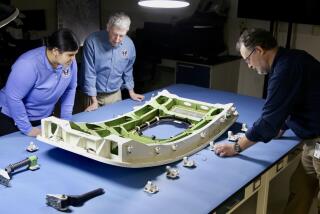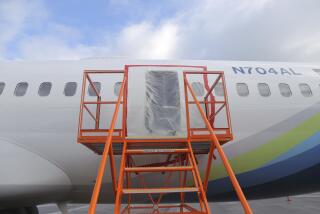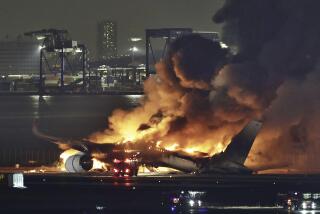Peeling Found in Flight 587’s Tail Fin
WASHINGTON — Federal safety investigators said Tuesday they have discovered internal damage in the tail fin of the American Airlines jet that crashed in November in New York, but further testing is needed to determine whether it occurred before or after the accident.
The National Transportation Safety Board said NASA scientists examining the 27-foot tail fin found that some layers of the advanced composite material used to build it had peeled apart from each other, a phenomenon known as “delamination.” It was the first tentative indication of possible flaws in the material.
The Airbus A300 jet’s tail fin broke off shortly after takeoff from John F. Kennedy International Airport, and Flight 587 crashed into a nearby neighborhood, killing all 260 aboard and five people on the ground.
The tail fin was built with composites, which are lighter and stronger than most metals. Composites are built of many layers of carbon fibers embedded in a special resin and molded together under heat and pressure. They lose their strength when delamination occurs, because the layers of material separate like pages of an open book.
The NTSB said its investigators continue to look for a mechanical malfunction or structural defect that may have caused or contributed to the accident. But they have not come across any evidence of an in-flight explosion or fire that might indicate sabotage.
“Some delamination has been noted,” the NTSB said in a statement, referring to the internal damage found in the tail fin. “But at this time, it is not known whether this occurred before impact or as a result of impact.” An Airbus spokesman declined to comment.
The NTSB said tests at NASA’s Langley Research Center in Virginia will “take many more months.” Up to now, the tests have been conducted with ultrasound and other scanning devices. New tests will be “more extensive and intrusive,” the NTSB said.
Investigators are also scouring airplane junkyards for a tail fin from another A300 to take apart. The tail fin--also known as a “vertical stabilizer”--helps keep an aircraft flying straight. Engineers design such components to be many times stronger than any forces a plane would encounter in flight.
Ever Barbero, an engineering professor at West Virginia University and an expert on composites, said it will be very difficult to determine whether the delamination was due to a preexisting flaw.
“A failure of the material is not localized--it spreads,” Barbero said. “And when it spreads, it creates delaminations. Whether that delamination was there before or after the crash, who knows?”
The tail fin and the plane’s rudder--pulled from Jamaica Bay about a mile from the Queens neighborhood where the main fuselage crashed--showed little visible damage. In the seconds before the crash, the flight data recorder registered several sharp, unusual movements of the rudder, which is part of the tail fin assembly and is used to help steer the aircraft.
Investigators have not been able to determine whether those movements were commanded by the pilots as they flew through the wake of a heavier jet ahead, or whether they were caused by the tail starting to come off or some other event.
Airbus discovered a delamination in the tail fin of the plane while it was still at the factory. But the company said the flaw was repaired using approved procedures, and the aircraft was put into service with no additional requirements beyond routine inspections.
More to Read
Sign up for Essential California
The most important California stories and recommendations in your inbox every morning.
You may occasionally receive promotional content from the Los Angeles Times.










